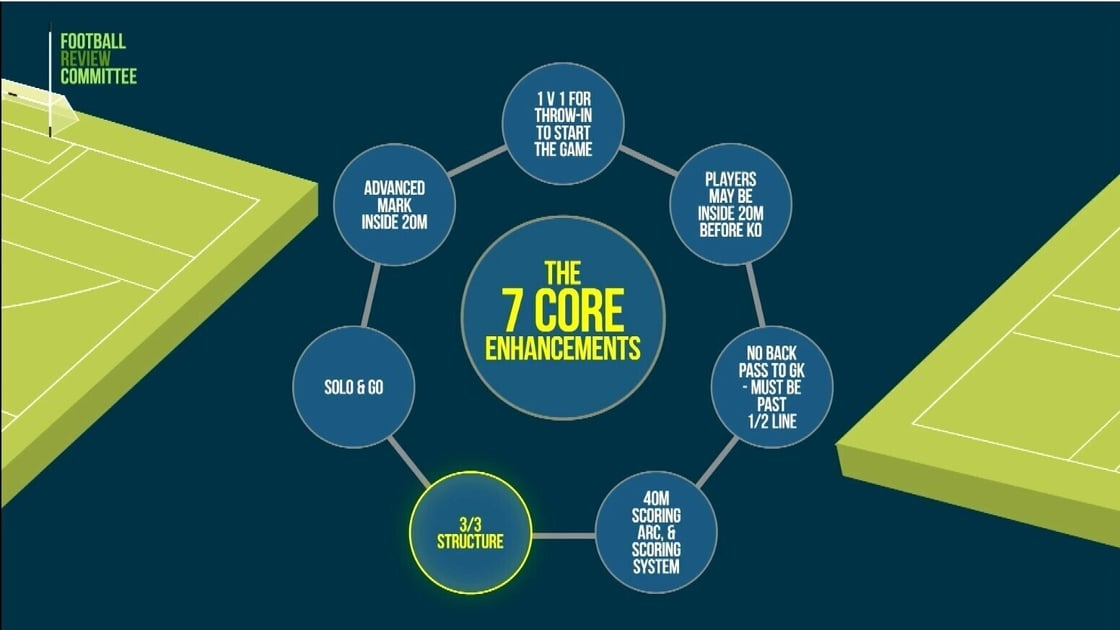A weekend of reckoning for Gaelic Football
New rule changes will be trialed this weekend in an effort to revolutionise the game.
Hey there! It’s been a while. Despite my best intentions, its never easy to keep up with posting consistently as life, work and other things get in the way. I’d love more than to be on here every week casting an eye to events across the water, lamenting the Irish football team or heralding Arne Slot, but that’s not always to be. So let’s take a look at something different this week.
I’m conscious writing this that, thanks to the fine Substack community, I have several readers from outside the island of Ireland that simply care not for Irish sport but this one, in some part, is aimed at them.
Because I pose the question – in what sports, can you recall, has an entire weekend been set up to determine the future overhaul of its entire existence, based on four trial games in an 80,000-seater stadium, televised on national television for all to see?
Because that’s what the Gaelic Athletic Association, the powers that oversee the Gaelic Games of hurling and football in Ireland, are doing this weekend in an effort to combat the rut Gaelic football has found itself in over the past number of years, a game played in near every corner of the country, but buoyed down by negative play, cautious tactics and coaching, and what has become a fairly bleak sight for increasingly reluctant spectators.
(For any international readers who are unfamiliar with Gaelic football, this video might help, but think a combination of soccer, except you can pick up the ball in your hands, and rugby.)
A number of rule changes have been proposed by a Football Rules Committee headed by a former six-time All-Ireland winning manager, Jim Gavin, who led Dublin to a historic five-in-a-row title charge between 2015 and 2019. The fact such an effort is headed by someone so well respected in the game has given it far more credence, as if Bill Belichick was leading the charge on rule changes in the NFL. Ultimately, the aim of the changes is to make the sport faster, more attacking, more-free flowing, and altogether a more entertaining and enjoyable spectacle for fans.
Why? Because over the last maybe 10 years or so, as players become more athletic and fine-tuned than ever, and tactics and systems became more ingrained, the game has slowly become more difficult to watch, because there is not enough incentive to be overly attacking. There is no reason for teams in the lead to risk an attack and lose possession, whilst teams who are trying to draw back a deficit are met with a wall of defenders as all 15 oppositions players flock into their own half. It’s boring, hard to watch and has seen a reduction in attendances and an alienation of casual fans.
The rule changes are listed below, with more in depth explanations here, but for context on what the sport has become in recent years, let me see if I can find an analogy with sports elsewhere. Let’s say, NFL coaches suddenly believed that a three-point field goal was enough to win a game. Sure, they might fluke a few more scores, but once they had their lead they would instantly start winding down the clock, take a few kneel-downs, happily go backwards if they needed to, just to retain possession for as long as possible. When the other team had possession, they would pile everyone behind the ball and deep towards the endzone, as if they were defending a Hail Mary situation on every play.
An analogy is more difficult in basketball because they have the rather helpful backcourt rule whereby if you pass the half-way you can’t return, as well as the shot clock which incentivises shooting before a 24 second period has elapsed. Imagine those two rules magically disappeared from the NBA and teams could just hog the ball in their own half, refusing to enter opposition territory.
The half-court rule and the shot clock were actually two ideas considered for Gaelic Football, which is played on a massive field rather than a relatively small court. It may or may not have worked as well as it does in basketball but that’s how desperate things are for change. The resolution instead is to outlaw passes back to the goalkeeper in most circumstances, which in recent years has become a get-out-of-jail clause for teams as they sought to cautiously retain possession, kind of like when in association football goalkeepers were allowed to pick up passes back to them from their teammates.
On Friday and Saturday, each province of Ireland will pitch together a roster of their finest in an All-Star like situation to go out and play under the new rules. There are new lines drawn on the pitch, new things to be mindful of and, rather worryingly, referees that need to be studied up on all of the radical changes.
It will undoubtedly have a few teething problems but should the weekend go through without any major hiccups and onlookers and officials alike like what they see, the new changes will be pushed through for submission and the game of football will change wholeheartedly in perhaps on of the largest one-off overhauls of a legacy sport in recent history.
Much like how the offside rule revolutionised football, or the recent advent of video referee and technology has become a feature in most sports, this takes that level of alteration to a whole new level, ripping up the rulebook on a whole new adaptation of a sport that is loved by hundreds of thousands across the country. Many communities are built around the sport, clubs and counties train their hardest to compete, and should this radical new world we’re entering get the green light this weekend, it’ll be back to the drawing board for Gaelic Football 2.0.




